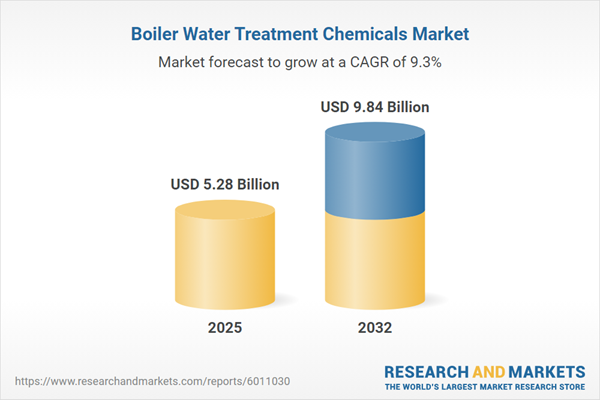Speak directly to the analyst to clarify any post sales queries you may have.
Senior leaders in industrial and infrastructure sectors are accelerating investments in advanced boiler water treatment chemicals to safeguard operational reliability and regulatory compliance. As sustainability expectations and technological advancements increase, tailored water treatment strategies are central to ensuring business continuity and competitive positioning.
Market Snapshot: Boiler Water Treatment Chemicals Market Overview
The boiler water treatment chemicals market is experiencing robust growth, underpinned by rising global infrastructure projects and intensifying regulatory demands. Market forecasts show an increase from USD 4.84 billion in 2024 to USD 5.28 billion in 2025, with a compound annual growth rate (CAGR) of 9.27%. The sector could reach USD 9.84 billion by 2032. This expansion is driven by heightened industrial activity in energy, petrochemical, and manufacturing environments adopting digital chemical monitoring. Evolving regulations are prompting companies to modernize water treatment protocols, minimize risk, and prioritize uptime for complex assets.
Scope & Segmentation: Boiler Water Treatment Chemicals Market
- Treatment Types: Includes alkalinity controllers, biocides, corrosion inhibitors, defoamers, dispersants, and scale inhibitors. Core chemistries—such as azole, carboxylate, nitrite, phosphate, organophosphates, phosphonates, polyacrylates, and specialized polymers—address asset protection and chemical management needs.
- Application Areas: Chemical manufacturing, petrochemicals, oil and gas, power generation, food processing, and pulp and paper each require precise water quality standards and equipment risk controls for operational continuity and compliance.
- Boiler Types: Both fire tube and water tube designs are served, meeting varying maintenance and pressure requirements in diverse industrial settings.
- Service Modalities: Providers deliver chemicals, technical consultation, on-site assessments, workforce training, and digital monitoring integrations, offering adaptive support for plant management.
- Product Forms: Liquid, powder, and tablet formats enable flexible dosing and integration for varied plant designs and operational scales.
- Regional Coverage: A global market, covering the Americas, Europe, Middle East and Africa, and Asia-Pacific. Demand is particularly strong in the United States, China, India, Germany, and Brazil, where local regulations and supply chains directly influence adoption.
- Leading Companies Profiled: Profiles include Ecolab Inc., Solenis LLC, Nouryon Chemicals B.V., BASF SE, Kemira Oyj, Kurita Water Industries Ltd., Veolia Environnement S.A., SNF S.A., LANXESS AG, and Thermax Limited. These organizations provide insight into partnership strategies and regional presence.
Key Takeaways: Strategic Insights for Senior Decision-Makers
- Digital monitoring and remote analytics now support real-time operations, enhancing transparency and contributing to stable performance in mission-critical environments.
- Adoption of sustainable and phosphate-free chemical solutions is expanding rapidly as organizations strive to meet ESG criteria and comply with global regulatory updates.
- Customizable chemical protocols allow enterprises to address unique site risks, strengthening risk mitigation approaches across varied facilities and geographies.
- Collaborative efforts involving chemical suppliers, OEMs, and engineering experts are improving compliance and driving reliable system performance under changing industry conditions.
- Procurement practices are shifting toward localized suppliers, reducing vulnerability to global disruptions and enhancing the responsiveness of supply chains.
Tariff Impact: Navigating Global Trade and Sourcing Dynamics
Recent U.S. tariff changes have altered the cost structures and sourcing models of boiler water treatment chemicals. In response, executive teams are expanding supplier networks across Asia and Europe and focusing on regionally adaptive procurement strategies. Joint initiatives with suppliers and focused scenario planning are helping organizations maintain operational resilience amid volatile trade environments.
Methodology & Data Sources
The report synthesis draws on senior executive interviews and consultations with technical specialists. Rigorous regulatory reviews and academic research validation ensure that guidance and findings are accurate and actionable for leadership navigating evolving market conditions.
Why This Report Matters
- Supports benchmarking of water treatment and risk strategies, offering a clear view of operational strengths and areas for improvement across major industries and regions.
- Provides an impartial assessment of technology trends, sustainability adoption, and supply chain resilience to drive efficient procurement and regulatory compliance.
- Informs executive decision-making by contextualizing regulatory and technological shifts, enabling effective alignment of corporate strategy with market dynamics.
Conclusion
Chemical innovation, digital integration, and cross-sector collaboration are shaping the future of boiler water treatment. Integrated approaches position executive teams to respond confidently to new operational and compliance challenges.
Additional Product Information:
- Purchase of this report includes 1 year online access with quarterly updates.
- This report can be updated on request. Please contact our Customer Experience team using the Ask a Question widget on our website.
Table of Contents
3. Executive Summary
4. Market Overview
7. Cumulative Impact of Artificial Intelligence 2025
Companies Mentioned
The companies profiled in this Boiler Water Treatment Chemicals market report include:- Ecolab Inc.
- Solenis LLC
- Nouryon Chemicals B.V.
- BASF SE
- Kemira Oyj
- Kurita Water Industries Ltd.
- Veolia Environnement S.A.
- SNF S.A.
- LANXESS AG
- Thermax Limited
Table Information
| Report Attribute | Details |
|---|---|
| No. of Pages | 191 |
| Published | November 2025 |
| Forecast Period | 2025 - 2032 |
| Estimated Market Value ( USD | $ 5.28 Billion |
| Forecasted Market Value ( USD | $ 9.84 Billion |
| Compound Annual Growth Rate | 9.2% |
| Regions Covered | Global |
| No. of Companies Mentioned | 11 |









